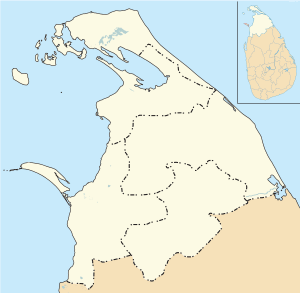Mullaitivu fort
| Mullaitivu fort | |
|---|---|
| Part of Mullaitivu | |
| Mullaitivu, Sri Lanka | |
 Remains of Mullaitivu Fort | |
 location of Mullaitivu | |
| Coordinates | 9°16′59″N 80°48′00″E / 9.283°N 80.8°ECoordinates: 9°16′59″N 80°48′00″E / 9.283°N 80.8°E |
| Type | Defense fort |
| Site history | |
| Built | 1715 |
| Built by | Dutch |
| Battles/wars | Several |
Mullaitivu fort (Tamil: முல்லைத்தீவுக் கோட்டை, translit. Mullaittīvuk Kōṭṭai; Sinhalese: මුලතිවු බලකොටුව Mulathivu Balakotuwa) was built by the Dutch in Mullaitivu, Sri Lanka. The original fort, a small wooden structure with palisades and earth, was erected in 1715. In 1721 the Dutch constructed a quadrangular fort on the site. The fort was initially erected to control the unauthorised commerce between the Chetties and the Kingdom of Kandy, it subsequently formed part of a strategic defence of Dutch territory against the Vannimai.
The fort was rebuilt by British during their occupation of the country in 1795.[1] On 25 August 1803 the fort was captured and destroyed by forces led by Pandara Vanniyan.[2][3] The commander of the fort, Captain von Driberg, and his troops garrisoned at the fort managed to escape by boats to Jaffna.[4] Pandara Vanniyan and his forces were subsequently defeated by Captain von Driberg and the British troops at Kachchilamadu on 31 October 1803.[3][4]
References
- ↑ "Dutch fort at Mullaitivu". AmazingLanka.com. Retrieved 20 November 2014.
- ↑ Somasundaram, Daya (2014). Scarred Communities: Psychosocial Impact of Man-made and Natural Disasters on Sri Lankan Society. New Delhi: SAGE. p. 52. ISBN 9788132111689. Retrieved 19 November 2014.
- 1 2 "Pandara Vanniyan memorial place destroyed in Katchilaimadu". 23 April 2010. Archived from the original on 29 November 2014. Retrieved 19 November 2014.
- 1 2 "The Kandy war and the reprisals". Sunday Times. 31 August 1997. Retrieved 19 November 2014.
_fort.jpg)